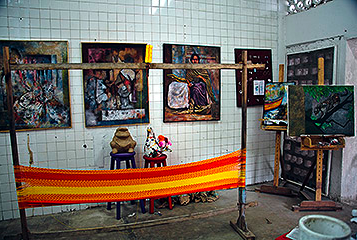Mexican Prison Art
Jenny McBain finds out about an extraordinary prison in Mexico where creative endeavour keeps violence at bay.
Prisons need not be concrete incubators of violence and despair. At best they can kindle the lingering spark of humanity that often resides within the heart of even the most hardened offender and set them on the road to a fulfilling life.
Cereso Prison in Chetumal, Mexico is a fine example of how this can be done. Astonishingly, there has been no violence within its walls in the last ten years and its governor feels at liberty to walk around amongst the thousand or so inmates with out armed escort. So how is this achieved?
Well, inmates are encouraged to become practising artists and craft makers and are allowed to sell their work in the prison shop, keeping the proceeds to give to their families. American travel writer Judy Fein who is a collector of prison art, chronicles her visits there in her fascinating book ‘Life Is A Trip- the transformative magic of travel’
She claims that a visit to Cereso changed her mind about how convicted criminals should be treated. She says, “Treating prisoners as human beings, encouraging their skills, their intelligence and their creativity can help to reduce the horrendous problems of violence and recidivism in our prisons. This is not pie- in –the- sky thinking. It’s happening right now in that little known Mexican prison.”
Cereso does more than just encourage creative entrepreneurship. Inmates also have access to a well stocked library and are encouraged to take language classes and to learn I T skills. Sports participation is a key cornerstone of institutional culture here too, so there are football and basketball teams.
 Disagreements are settled in the boxing ring where participants are given protective padding and allowed to slug it out. After about two rounds, anger dissipates and the dispute is over. And stress- busting alternative therapies- such as Reiki and Swedish massage treatments- are available for a modest fee.
Disagreements are settled in the boxing ring where participants are given protective padding and allowed to slug it out. After about two rounds, anger dissipates and the dispute is over. And stress- busting alternative therapies- such as Reiki and Swedish massage treatments- are available for a modest fee.
Perhaps more controversially, occasional conjugal visits are allowed in a designated room. These, the prison authorities say, help to release pent up sexual tension. And children who are conceived and born in the prison to parents who are both inmates are raised there. Visiting off spring, meanwhile, enjoy designated playground areas.
If these kind of penal practises are to catch on internationally, a sea change of attitudes is required. It will only become possible to run a more humane and effective prison system when deprivation of liberty is seen as punishment enough for transgression. At that point a positive ethos of rehabilitation could garner widespread support and financial investment and we would all benefit from falling crime rates.
Judy Fein is absolutely convinced that other nations can learn from the regime in Cereso prison. She says, “At home, I smile every time I open my closet and see a large brightly- coloured purse made from the foil shrink wrapping from plastic soda bottles. I bought it for $20 at the prison and I can still see the beaming, round face of the man who sold it to me. Victor told me it would help him feed his family, so I got a purse and a good feeling for a few dollars.”
Co- founder of the Big Issue, John Bird, credits his time inside gaol many years ago as having given him an opportunity to learn to read and to acquire an education. Without that positive input, John would not have been able to move on and lead a useful life and we would most probably be deprived of his particular brand of social journalism!
John now despairs at the lack of opportunity in modern UK prisons and is keen to give a platform to innovations that could address the problem of how best to treat offenders. Perhaps he will make a trip to Mexico to find out more.















Write Your Comment